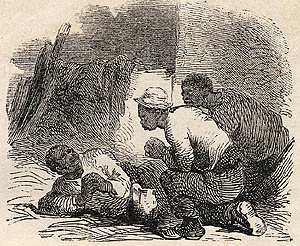Analysis: The Message of Uncle Tom's Cabin

Stowe's primary objective of writing Uncle Tom's Cabin was to show African Americans and slaves as people, rather than property. The book was targeted mainly towards Northern Protestants, though it did reach an international audience. Many Northerners, like the character of Miss Ophelia in the novel, disliked slavery but were still prejudiced against against blacks. For example, Ophelia is an abolitionist but does not want to touch blacks and wants minimal interaction with them. Stowe hints at racism even in the North; however, Ophelia is given Topsy to raise, and she eventually realizes her faults. Stowe believes that much of the North's prejudice stems from ignorance rather than experience, and the novel is meant to educate society to see slavery in its true light. (Pictured above: Ophelia and Topsy)
Furthermore, the personal issues faced in the novel allowed some Southerners to sympathize with the characters, such as St. Clare in the story, though others did become outraged. Stowe constantly shows the separation of families and the lengths mothers go to protect their children, such as Mrs. Shelby encouraging Eliza to escape with Harry after he is sold. These universal ideas, along with the common thread of Christianity, are used to argue that blacks are not so different from whites and should not be mistreated.
Religion and Uncle Tom
Uncle Tom is the deeply religious protagonist of the novel, and Stowe encourages her readers to follow his actions to abolish slavery. She writes about Tom's loyalty to his masters and selfless manner in a positive light, despite his traits being the cause of his death. Instead, Tom is a "perfect" Jesus figure, sacrificing himself to help others and even forgiving Legree and his overseers. Stowe holds up Tom's death as being noble, better than escaping since he maintans his Christian values until the end, in sharp contrast to Legree's lack of principles. In fact, the emphasis on Tom being a fellow Christian was used by Stowe to connect Northern readers to the character. Tom is a martyr, one that inspires everyone and leads to Shelby freeing his slaves.

The common thread of Christianity also symbolizes characters' positions on race and slavery. In fact, Stowe points out that the two contradict each other through the characters. In the novel, the more devout a character is, the stronger he or she feels against slavery. Eva, the little girl Tom saves from drowning, connects with Tom over Christianity and loves everyone, regardless of their race. On the other hand, Legree is not religious and the direct opposite of Eva. Even so, Stowe demonstrates that by converting to Christianity, people can change for the better. Legree's overseers convert and become better men after Tom forgives them, and Loker the slave hunter assists Eliza in escaping after he is shot and healed by the Quakers. Thus, Christianity is a form of universal love, one that Stowe believes her audience can use to fight slavery.
George Shelby, after Tom's deathWitness, eternal God! Oh, witness that, from this hour, I will do what one man can to drive out this curse of slavery from my land
The evil of slavery
Ultimately, Stowe acknowledges both extremes of slavery in Uncle Tom's Cabin, represented as the north and south of the southern United States. However, even though Shelby is kind of Uncle Tom and his slaves, his financial problems still lead to suffering and families being separated, as does St. Clare's unexpected death. Stowe's novel constantly advocates the emancipation of all slaves by exposing what slavery can do. It attacks the Fugitive Slave Act in a subtle way, but one that claims freedom is the only way for slaves to be truly happy. In turn, the novel has made its mark on American history, leading to a variety of reactions from readers and supporting the abolitionist movement.